 This page has been mothballed.
This page has been mothballed.
It is no longer being updated but we've left it here for reference.
Foot and Mouth Research
Agroforestry
Re-structuring of farms after Foot and Mouth Disease could lead to the introduction of novel and more diverse land-use systems. One such system is agroforestry.
The International Centre for Research in Agroforestry (ICRAF) provides the following definition of agroforestry.
"Put simply, agroforestry is using trees on farms. ICRAF defines agroforestry as a dynamic, ecologically natural resources management system that, through the integration of trees on farms and in the landscape, diversifies and sustains production for increased social, economic and environmental benefits for users at all levels."
- There are two main types of agroforestry system appropriate to the UK:
- Silvopastoral systems in which trees are mixed with grazing animals.
- Silvoarable systems in which trees are planted in rows with an arable crop in the alleys between.
The Macaulay Land Use Research Institute has been carrying out research on silvopastoral agroforestry systems for a number of years.
- Research on silvopastoral agroforestry at the Macaulay has shown that:
- Trees can be planted at wide spacing within sheep-grazed pastures with no reduction in agricultural productivity for up to ten years with fast growing tree species (for example, hybrid larch, see graph below) and for at least twelve years with slower growing tree species (for example sycamore and Scots pine).
- Pruning of trees reduces shading of the pastures and can result in high levels of agricultural productivity even after ten or twelve years (see graph below). Pruning will also increase the quality of the timber grown.
- In dry summers, for example in the east of Scotland, pasture production below well-grown agroforestry trees can be up to 16% greater than conventional pastoral agriculture (see graph below). This occurs because of modifications to the micro-environment which reduce evapotranspiration and protect soil moisture.
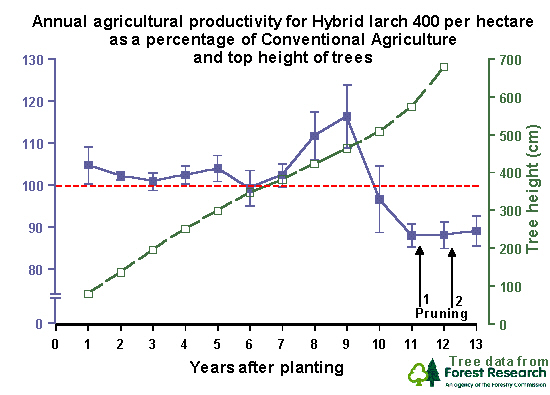 This graph shows that for the first 7 years, even as the trees grow taller, annual agricultural production was unchanged. It then increased to year 9 over two dry summers. Year 10 was a wet summer with no advantage to agroforestry. In year 11 the tree canopies were big enough to shade the pasture significantly. After that, pruning of the trees held agricultural production at 90% of conventional pastoral
This graph shows that for the first 7 years, even as the trees grow taller, annual agricultural production was unchanged. It then increased to year 9 over two dry summers. Year 10 was a wet summer with no advantage to agroforestry. In year 11 the tree canopies were big enough to shade the pasture significantly. After that, pruning of the trees held agricultural production at 90% of conventional pastoral
- Sheep make use of the trees for shelter, reducing their energy needs and improving animal welfare.
- Agroforestry pastures start to grow earlier in spring and grow on later in autumn providing extra "bite" at critical times (during lactation and pre-mating). The trees will also provide shelter to the sheep.
- Agroforestry systems attract more species and more numbers of ground insects than conventional pastoral agriculture, expanding the food web and increasing "biodiversity".
- Agroforestry systems attract both open-field and woodland birds.
- Agroforestry systems, with their open woodland appearance, add a new dimension to conventional pastoral landscapes (see images below).
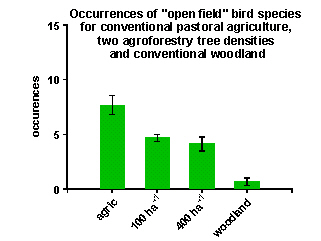
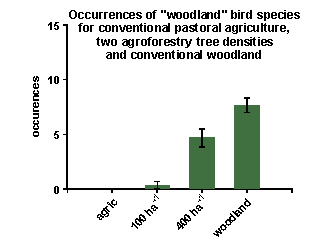
The pictures below show silvopastoral agroforestry at the Macaulay Land Use Research Institute. Each field contains only one species of tree and the trees are planted in straight lines on a square grid pattern for purposes of our research. On-farm, tree species can be mixed within a field and trees can be planted at irregular spacings, if necessary, to improve the overall appearance.
For more information contact: Alan Sibbald
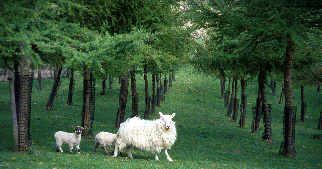 |
Hybrid larch agroforestry12-year old hybrid larch planted at 400 per hectare. The trees have been pruned to half of their total height. |
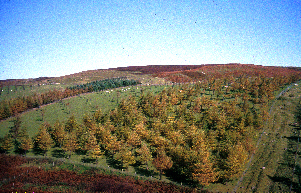 |
Hybrid larch agroforestryA general view of a plot of 10-year hybrid larch. At this stage, there was no reduction of agricultural productivity below the trees. |
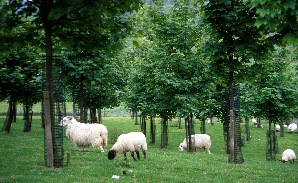 |
Sycamore agroforestry12-year old sycamore planted at 400 per hectare. The trees have not reduced agricultural production. |
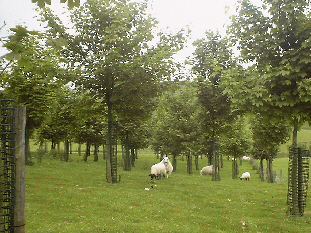 |
Sycamore agroforestry12-year old sycamore planted at 400 per hectare. |
 |
Scots pine agroforestry12-year old Scots pine planted at 400 per hectare. The trees have not reduced agricultural production. |

